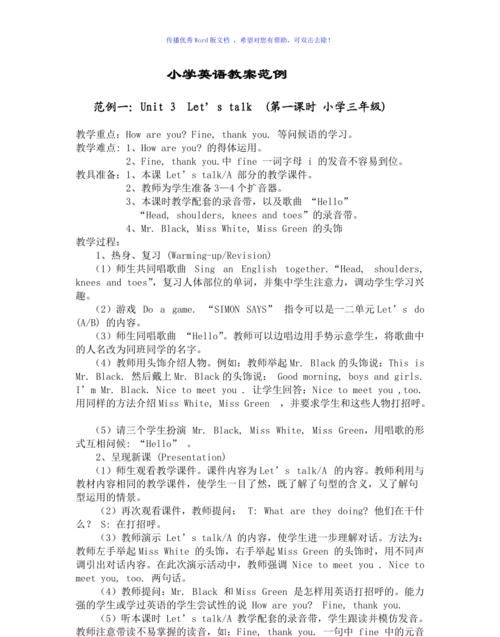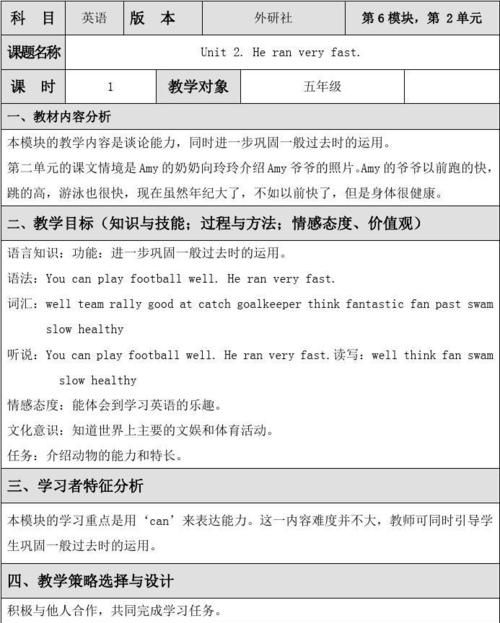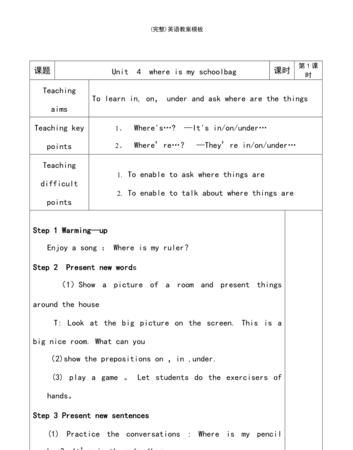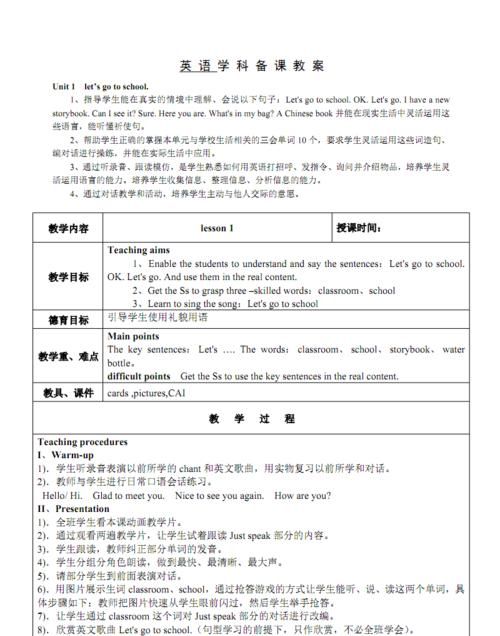本文目录
小学英语教师支教总结报告
没有教材么?我是天津的,我们一二年级口语课用的教材是《快乐英语》,对于一二年级有些难,我们只教一部分,估计三四年级差不多,你可以看看,还有一个《剑桥少儿英语》也不错,其他的方式可以采取每天课前找人做duty或daily
speech之类的,电影最好是动画片,狮子王、功夫熊猫之类的,学唱英文歌也是锻炼口语很好的方式,加油喽~

人教版pep小学英语六年级下册教案
Unit 1 How do you go there?
Period One
Teaching contents: Part A
let’s
learn &
let’s
play
Teaching aims:
1
.
To enable the students to master the four skills phrases: on foot
,
by bike
,
by
bus
,
by train, by plane
,
by ship
,
by subway
2
.
To enable the students to ask about the ways of traffic with the following
sentence patterns: How do you go to school? Or How do you go to
Canada…?‖
And
answer with―I go by…‖
Teaching focus:
To master the
four skills phrases
: by train, by plane, by subway, by ship, by bike,
on foot
Teaching difficulty:
To differ ―subway‖ from―train‖
Teaching methods:
Communicative Approach
Teaching aids
:
1.
Word cards
2.
Tape recorder and tape
3.
Multi-media player
Teaching procedure:
1.
(Warm-up)
Greeting: Good morning ,
class !
Glad to meet you again. How are you?
What day is it? What ‗s the date?
What‘s the weather like today?
2. Presentation
Show a picture of bus
T: What‘s this?
S: It‘s a bus.
T: I go to school by bus. How do you go to school?
(Show a picture of bike and help a
student to answer with ―I go to school by
bike.‖)
(In the same ways)
Teach ―by subway‖ and ―by train‖ ―by ship‖ ―by plane‖ ―on
foot‖.
Subway: It's an underground railway in a city
.
It travels very fast
.
We can see
subway in Hong Kong, Beijing, Shanghai, Gongzhou…
Explain the differences between subway and train
Pay attention to the pre. ― by‖& ―on‖
Unit
Unit 2
Where is the Science Museum?
Lesson
The sixth period
Teaching
Aims
Let‘s learn B—2
Let‘s try
Let‘s talk
Focus
1.
4 skills words and phrases:
turn left
turn right
go straight
2.
4 sk
ill sentences: Turn left at the cinema, then go straight. It‘s on the left.
3.
Well
know
the
dialogue
of
Let’’
s
talk
B
and
recite
it
and
then
use
it
flexibly.
Difficult
points
1.
The pronunciation and the spelling of the word ―straight‖
2.
How to get to somewhere by the map.
Teaching
aids
T: the word cards of both Part A
and Part B;
the tape
S: the 4 word cards and the places cards
Teaching Procedure
Teacher’s guide
Ss’ activity
I.
Warm-up
Play the tape.
Follow and Sing the song : How do
you go to school?
Enjoy
the
song
:
Where
are
you
going ?
II.
Preview
1.
Show the coordinate and review the 4 words learnt last
time.
2.
Recite the poem of Up, up , north ,north.
3.
Some Qs to review the position
4.
Have a dictation.
Spell the words
Recite the poem.
Answer the Qs .
Write
out
the
words
and
the
sentences:
east
west
north
south
Shanghai is in the east of China,
Hainan is south of Guangdong.
Go north for three days.
III.
Presentation
Let’s try
: listen and circle.
Let’s learn
1.Talk about the traffic signs on the road.
∣
→
←
∣
Teach
the
phrases:
left
right
turn
left
turn
right
on the left
on the right
2. ←
↑
→
One way means go straight ahead.
straight
go straight
3. If the practice is not enough in unit 1, You can
Add a game here. SB P19
Let’s talk.
1. Look at the map, Where is the cinema?
Where is the post office?
2. I‘m here , on the left side of the cinema, how can I
get to the post office?
3. Play the tape recorder.
4. Flexible-usage of the dialogue.
How to get to the bookstore from the cinema?
How to get to the park from the school? etc.
Circle the answer B
Turn right!
Turn left!
Learn to spell the words
One way!
S- tr-ai-gh-t straight.
Answer
the
Qs
,answers
may
be
varied.
Listen to the tape and understand the
dialogue by guiding on the map .
Listen
and
repeat
and
act
our
the
dialogue.
Discuss and then give the answer.
Practise in pairs and then presentate.
Work
:
Copy
the
words:
left
right
straight
turn
left
turn
left
turn
right
go
straight
Translate the sentences:
1.
在电影院那里左拐,然后笔直朝前走。
2.
在公园处右拐,然后笔直朝前走,
3.
医院在左边,公园在右边。
4.
邮局紧挨着银行,电影院它的在左边,
Bb
Design
:
Unit 2
Where is the science museum?
←
∣
left
turn left
on the left
∣
→
right
turn right
on the right
∣
─
straight
↑ ↓← →
go straight
Turn left at the cinema , then go straight. It‘s on the left.
Teaching
Reflecting
Unit
Unit 2
Where is the Science Museum?
Lesson
The seventh period
Teaching
Aims
Consolidation and extension of
last lesson:
Group work
Activity Book P12-2, P14 ,P 16
Focus
1.
Activity Book P16
Use the map to go to a place.
2.
Talk and make dialogue.s.
Difficult
points
3.
AB P16 Read the map ,and tell how to get to the place that I want to go?
4.
Task time read the map and how to go to sw.
Teaching
Aid
A.B ,and the tape
AB
Teaching Procedure
Teacher’s guide
Ss’ activity
II.
Warm-up
Play the tape.
Follow
and
Sing
the
song
:
How
do
you go to school?
Enjoy
the
song
:
Where
are
you
going ?
II
.
Preview
5.
Let‘s talk
Read the dialogue of Let‘s talk.
有点长,请谅解,求采纳

小学英语教学的教案包括哪些部分
《学英语》第二册Lesson 4:Vegetables and Fruit
教学设计
教学目标:
1、 知识方面:说、认识、口头运用下列词汇:vegetables,fruit,morning,afternoon,evening.
能够表达自己对各种食物的喜好、需求:I like…I don’t like…
2、 能力方面:(1)能把所学单词运用到日常口语交际中,在适当的情境中能够灵活运用,如谈论自己对各种食物的喜好、需求。(2)帮助学生了解中西方文化的差异,拓展视野。
3、 情感、态度、价值观方面:关注学生的喜好、需求,营造宽松、民主、和谐的课堂氛围。通过多样性的活动,激发学生学习英语的兴趣,调动积极性,使学生在英语课堂中不断体验成功,感受乐趣,树立自信心,促进学生综合语言运用能力的发展。
教具准备:
各种食物卡片或实物,录音机,多媒体课件,学生自制的食物小卡片。
重点、难点分析:
说、认识、口头运用vegetables,fruit,表达自己对各种食物的喜好、需求是本课的重点。
第二部分Morning,afternoon or evening?内容多、句子长,是本课的难点。
教学过程:
Part 1:Greeting
[激情问候,营造宽松、民主、和谐的课堂氛围]
Part 2:Warming-up
Let’s chant.
Food
开饭了,食品摆了一满桌,
rice rice 米饭,米饭rice喷喷香,
noodles noodles 面条,面条noodles细又长,
dumplings dumplings 饺子,饺子dumplings包大馅,
fish fish 鱼儿,鱼儿fish鲜又鲜,
最后来碗soup,Hmmm…good!
[琅琅上口的歌谣,帮助学生记忆所学食物,调动积极性]
Part 3:Review
T:(手拿相应食物卡片)Would you like some …?
S:Yes,please.\No,thanks.
(如果学生回答Yes,please.教师带着动作、表情说…likes…并将食物卡片送给学生以示鼓励。如果学生回答No,thanks.教师带着动作、表情说…doesn’t like…)
[情境对话不仅复习了前面所学,而且适当的渗透like、dislike,为新授做准备]
Part 4:New Concepts
1、 用图片或实物学习vegetables,fruit.
[直观、形象,便于学生理解、记忆]
2、 用动作和食物卡片来演示:I like…I don’t like…
举起一张食物卡片,微笑着点头,边假装吃卡片上的食物,边说I like…
表演I don’t like…教师应做出摇头、皱眉、把卡片推到一边等动作。
[丰富的表情、动作帮助学生理解I like…I don’t like…有利于形象记忆]
3、 操练I like…I don’t like…
教师做示范,手拿相应的食物卡片,带着动作、表情说I like…I don’t like…What about…?之后,这名同学表演I like…I don’t like…What about…?指名另一名同学表演,依次传递。
[大量操练,学以致用,训练学生的听说能力]
4、 游戏:Are you hungry?
T:(教师手拿若干食物卡片或实物) Are you hungry?
S:(带着动作、表情) Yes, I’ m hungry. I want to eat. / No.
T:(手拿相应的食物卡片) Rice. OK?
S: Yes , I like rice./ No ,I don’t like rice.
T:(如果学生回答Yes , 教师把食物卡片送给学生)
Here you are .
S: Thank you .
T: You’re welcome .
T:(如果学生回答No ,教师继续推荐食物) Chicken.OK ?
S: Yes . / No .
这个游戏也可让学生与学生之间用自制的食物小卡片来做。
[游戏调动了学生的积极性,让学生从中体验了成功,感受了乐趣,巩固了所学知识]
5、《教科书》L4N1
听录音,看书跟读。
[听录音是学生接触地道英语的好机会,这个步骤一定不能省略]
6、利用形象、生动的肢体语言及多媒体课件学习本课的难点第二部分:Morning, afternoon or evening?
播放录音,让学生看书跟读。然后提问,检查学生的理解情况。例如:What does Jenny do in the morning?In the afternoon?In the evening?
[多媒体课件集声音、图像、动画、文字于一体,图、文、声并茂,使课堂教学变得更加直观形象、生动有趣,帮助学生理解本课难点,降低了教学难度,保护了学习兴趣]
7、旧曲新唱,用The family in our house 的曲调,唱I get up in the morning, 帮助学生进一步理解、巩固本课的难点。
8、Homework:
让学生学习Jenny,晚上睡觉前跟爸爸、妈妈说Good night,并教爸爸、妈妈说Sweet dreams.
[让学生回家“教”父母说英语,满足了学生的心理需求,使他们体验了成功,获得了成就感,学以致用]
Part 5:Class Closing
做《活动手册》L4N1
第1题,在四线三格中写单词vegetables、fruit,并画出自己最喜欢的蔬菜、水果。

小学英语试讲10分钟教案
前四个单词用实物图和实物学生很容易理解的.看图学单词或看实物学单词学生印象很深刻,可以让学生指认.当学生学会前四个单词的时候问同学们简单不简单啊,容易不容易学会啊.学生应该说出简单容易的,这个时候讲授easy这个词学生就明白了.

以上就是关于小学英语教案20篇 ,小学英语教师支教总结报告的全部内容,以及小学英语教案20篇 的相关内容,希望能够帮到您。

